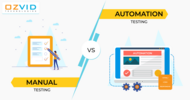- Mar 12, 2024
- Quality Assurance
- 6575
Share this post on:
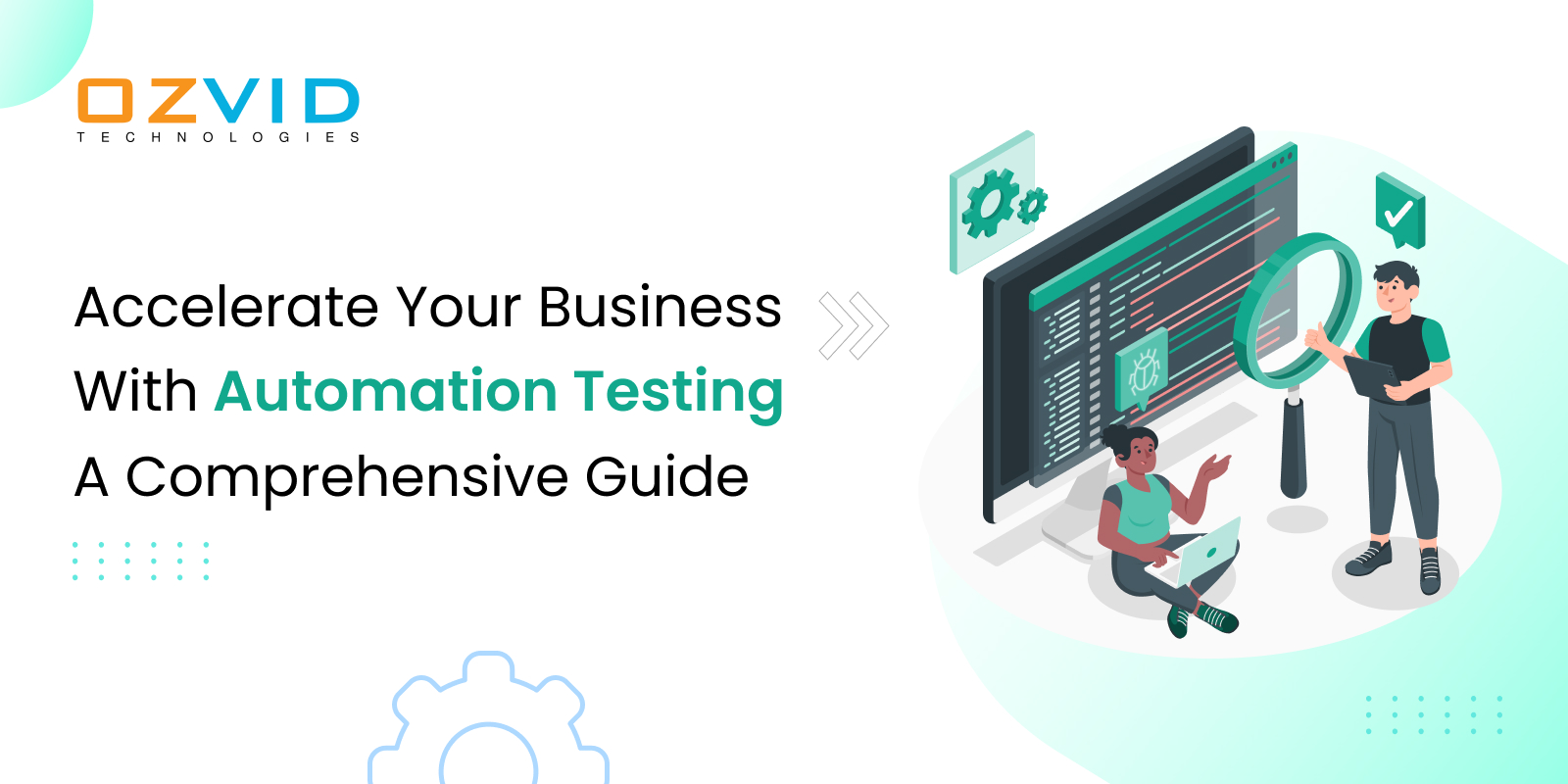
We are living in a quality-centric and highly competitive technological world. Businesses and customers choose products that are bug-free, scalable, and within their budget.
In this fast-paced business world, we cannot underestimate the value of software testing. Moreover, as the market grows and customer demands change, the testing process helps businesses and developers speed up time-to-market.
A survey says that the automation testing market size can reach USD 89.81 billion by 2030, growing at a CAGR of 19.36% from 2023 to 2030.
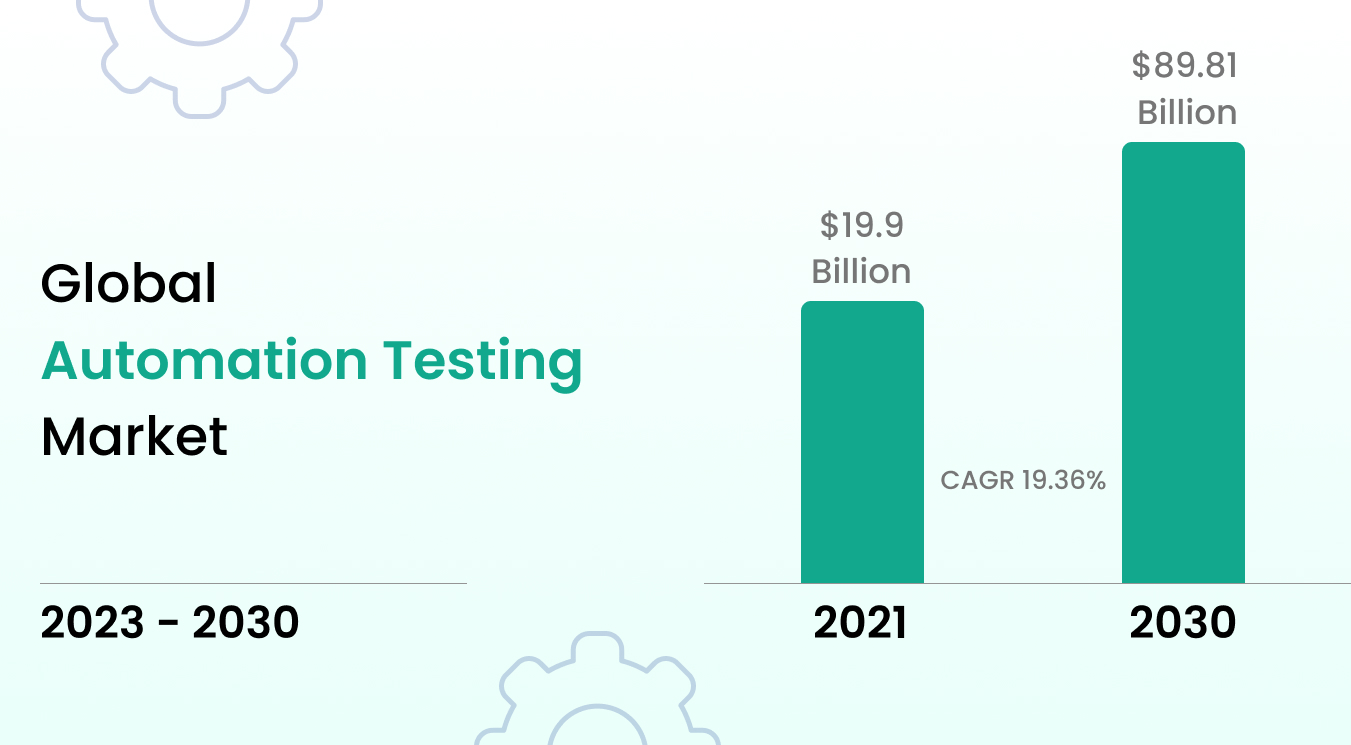
Automation testing uses an independent tool for testing. These tests compare the actual output with what was expected and generate reports. The goal of test automation is to enhance the effectiveness of testing while saving time. It is a critical part of the software development process, and with the advancement of open-source and low-cost tools, it has become more accessible.
Why choose Automation Testing over Manual Testing?
Manual testing requires developers to check the features and functions of the software. The process is complete without any assistance from available tools or software. Moreover, it is time-consuming and prone to human error. Also, as the software becomes more complex, it becomes difficult to scale.
In automation testing, industries use special tools to automate, find issues, and control test cases. Once the test cases are ready, they run without any human interference.
Automated testing is best for the testing of large and complex software. Moreover, automated tests can run across numerous platforms. We can use automated tests for agile development to help developers find bugs and speed up development.
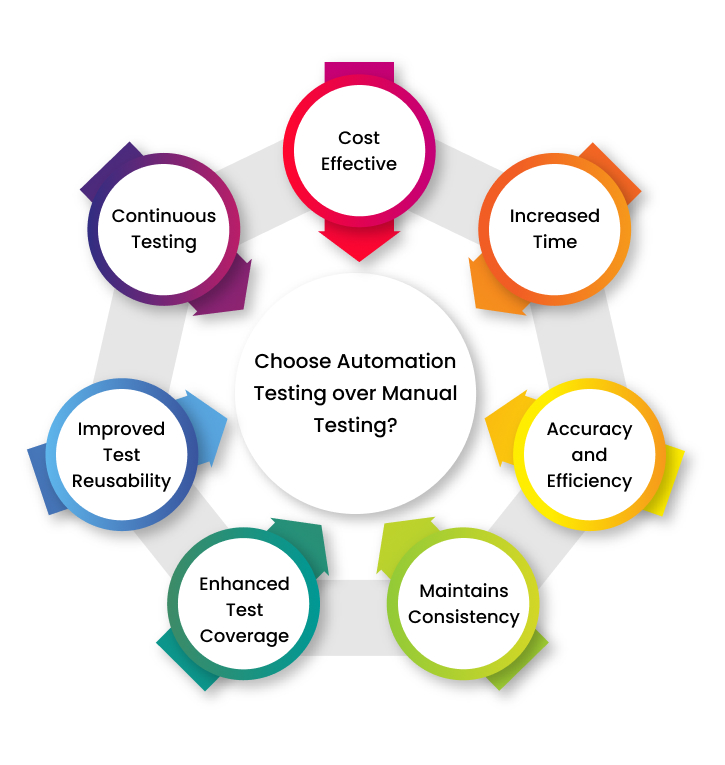
- Cost-effective: The initial investment can be high, but businesses can save on additional expenses with automation tests. Moreover, automation testing lets the task happen without any human interference, hence saving costs and time.
The test scenarios run automatically, allowing developers to focus their energy and resources on other important tasks, such as debugging which components or hardware broke under pressure, etc. This leads to a quicker return on investment (ROI) and helps businesses grow.
- Increased Time: The initial setup time of automated testing takes time and effort. But once the setup is in place, developers can re-use the test cases. These test cases are less prone to human errors and reduce testing time from weeks to hours.
Further, the complexity of the code might increase with time, making it difficult to test each functionality. But automated testing gives developers the flexibility to execute the test cases, increasing the complexity of the code.
- Accuracy and Efficiency: Manual testing is prone to human errors and can lead to inaccurate results. However, automated tests use the same steps, but are more accurate and reliable. Also, one crucial benefit of employing automation testing is increased efficiency during software development. By creating scripts for repeatedly running tests, developers can focus on new features and functionalities instead of performing repetitive tasks manually.
For example, UI-level validations would take humans hours, but automated tests take seconds to execute and analyze test scripts.
Additionally, automated test cases, once made, can be run as numerous times as required without putting in more incremental efforts, leading to better testing coverage.
- Maintains Consistency: The lack of testing consistency can cause crucial issues. If testing takes place manually, it can give inaccurate results, leading to more human effort, and less consistency. On the other hand, when testing is done through automation scripts, the output accuracy improves, resulting in more consistent results and less human effort.
- Enhanced Test Coverage: Automated testing can run on multiple browsers, devices, and operating systems. So performing the same steps of testing is a hectic process. But with automated testing, it is simple to run the same test cases again and again without any chaos. Moreover, using cloud environments for testing is also a great practice.
- Improved Test Reusability: Once the automated tests are created, they can be stored and reused numerous times as testers want. These tests can run on various systems, and testers do not have to re-create the cases.
- Continuous Testing: Automated tests can be run constantly and frequently at any stage of the development cycle. Moreover, these cases can integrate into the development pipeline. This makes it easy for test cases to run automatically every time code is improved, or any other code functionality is added.
Automation Testing: Types
It is crucial to understand the type of automated testing while working with automated tests. Let us take a brief look at the types of automation testing.
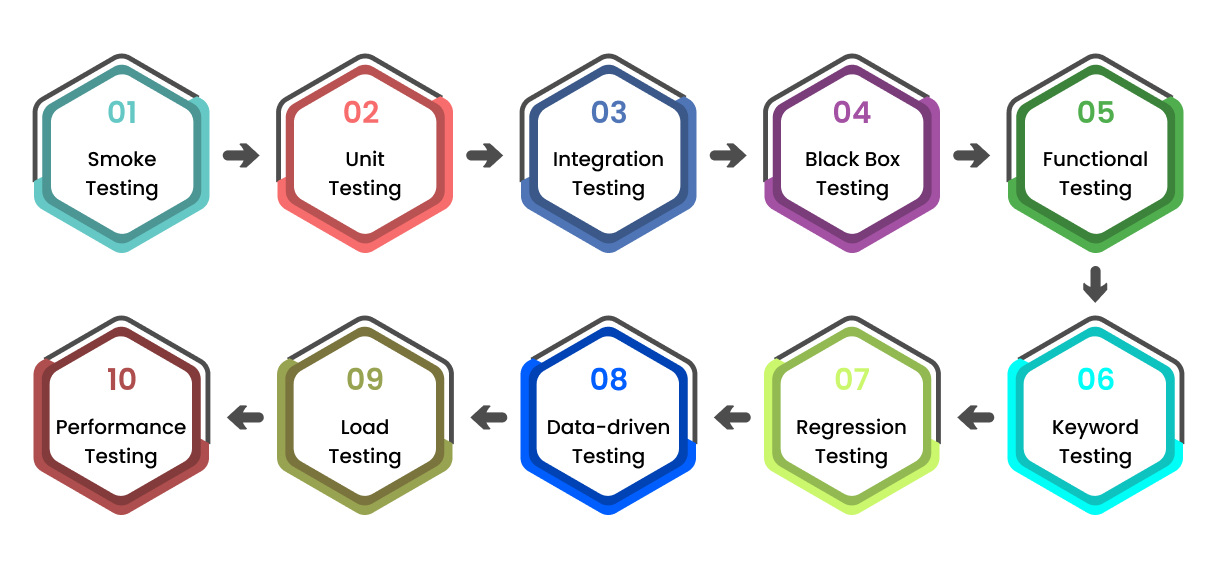
- Smoke Testing: Smoke testing refers to the early stage of functional testing. They aim to verify if most functionality is working as expected within the system. The main idea behind smoke tests is to identify crucial failures early on during integration testing. This reduces overall debugging time and focuses on catching bugs on time.
If the application passes the smoke tests, it means that the app will function properly and run successfully too. Running smoke tests give developers a chance to fix unexpected issues or problems.
- Unit Testing: Unit testing is the first phase of testing and involves testing individual components or units of the software, such as classes, functions, methods, etc. Unit tests simulate external dependencies like web services, databases, file I/O, environment variables, third-party libraries, network calls, and other modules in the app architecture.
Unit testing frameworks provide assertion methods to check expected outputs and verify if each component works according to specifications. It facilitates early detection of defects, making it possible to fix issues.
- Integration Testing: This type of testing checks how different parts of the application interact. Integration tests involve multiple components and databases working together to generate reports, update customer accounts, process transactions, render views, send notifications, respond to HTTP requests, etc.
The key goal is to identify data inconsistencies and cross-component failures before customers experience them live in production.
- Black Box Testing: In black box testing, the system is treated as a black box. It only observes input and output without going into internal details. These tests are performed from the user's perspective and do not require implementation understanding or code structure knowledge.
- Functional Testing: Functional tests are designed to verify whether the system functions according to specifications and requirements. These tests confirm if each feature performs correctly after code changes. They mimic user behavior to ensure correct input and output (I/O) processing via command line arguments, file I/O handling via APIs, and database interaction.
Functional testing typically depends on two sources they have required documents and application code. Requirement experts create functional test scenarios to match acceptance criteria, and developers provide technical details like API endpoints, field mappings, and local/remote authentication methods to functional testers.
- Keyword Testing: It is a functional automation testing framework that uses verbs from a spreadsheet to inform how each test performs. This testing does not require strong technical skills, as they use human language to describe the application process. These keywords are structured so they can be read and interpreted by machines.
Keyword testing allows developers to develop multiple scripts, making the test results easy to read and reuse.
- Regression Testing: This involves retesting of app’s functional and non-functional features whenever some changes are made in the code. Once a change is implemented or new features are added, regression testing reconfirms if the previously developed function is still responding correctly or not. This ensures that the faulty changes are not pushed to production or future releases.
- Data-Driven Testing: In data-driven testing, test data is stored separately from the test script itself. These test reads the test data and uses it to determine what actions to take and what expected results to verify. This tests testers to plug in the right values and helps them get better results.
- Load Testing: Load testing helps in determining the strength or efficiency of software or applications under realistic load conditions. These tests measure the strength and analyze its overall performance under normal and peak usage scenarios. Load testing determines a product's behavior when subjected to different loads. Performance characteristics measured include response time, throughput, database queries per second, database connections, etc.
- Performance Testing: These tests evaluate applications, speed, scalability, and stability of a system under demand. During performance testing, it checks if a service or system performs well enough in terms of factors such as maximum capacity, concurrency, stress, and more. Tools may inject various types of loads to observe the effects in terms of network latency, use of CPU, memory, storage space, connection timeouts, usage patterns, business cycles, infrastructure updates scheduled, etc.
Automation Testing: Frameworks
Now that we have discussed the types of automated testing, let us learn and identify the type of automation testing framework you want to use. Here are the testing frameworks that developers and businesses must know.
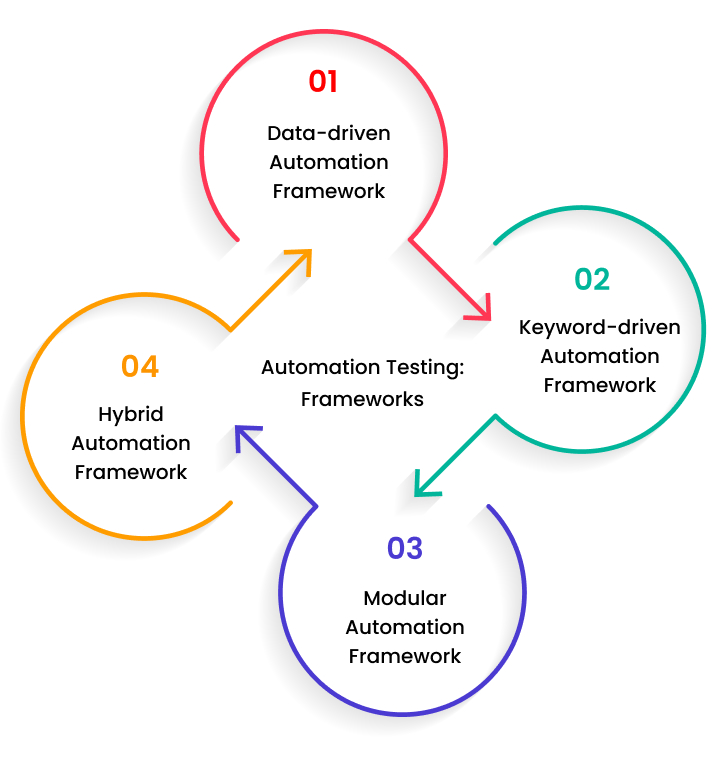
Data-driven Automation Framework: Allows test scenarios to read and execute data directly within test steps rather than hard-coding input values. Additionally, it allows the reuse of existing test frameworks and architectures instead of building new ones.
Keyword-driven Automation Framework: A keyword-driven automation framework refers to a type of test automation structure that involves using predefined keywords or arguments. The framework combines those keywords during the test creation process rather than writing complex coding logic This model is based on separating test instructions from test implementation.
Modular Automation Framework: A modular automation framework is an approach that breaks down large applications or programs into smaller, manageable blocks called modules. Within this architecture, each module serves one or multiple purposes without overlapping the efforts.
Hybrid Automation Framework: A hybrid automation framework combines traditional programming techniques and the usability of keyword-driven models. A hybrid automation framework combines various approaches and tools from keyword and data-driven frameworks to achieve the benefits offered by both models.
Conclusion:
In conclusion, automation testing is a crucial software development life cycle element. The process ensures the quality and reliability of the product. Moreover, it gives confidence to management and customers. They have upfront costs and take less time to develop.
Overall, automated testing is the fastest way to check the functionality of your product, and developers can fix the bugs and make required changes.
So if you are finding Automated Testing Services to fasten your development process, OZVID Technologies is here to help.
We at OZVID, are a leading custom software development company in the market. We offer the most robust and reliable automation services to enterprises of all sizes. To know more, contact us.










